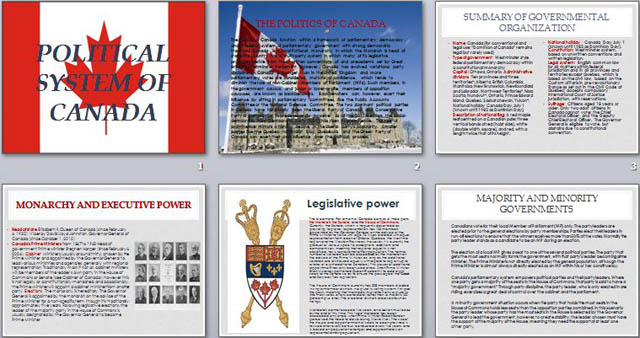
Political System of Canada

The Politics of canada
The politics of Canada function within a framework of parliamentary democracy and a federal system of parliamentary government with strong democratic traditions. Canada is a constitutional monarchy, in which the Monarch is head of state. The country has a multi-party system in which many of its legislative practices derive from the unwritten conventions of and precedents set by Great Britain's Westminster Parliament. However, Canada has evolved variations: party discipline in Canada is stronger than in the United Kingdom and more parliamentary votes are considered motions of confidence, which tends to diminish the role of non-Cabinet Members of Parliament (MPs). Such members, in the government caucus, and junior or lower-profile members of opposition caucuses, are known as backbenchers. Backbenchers can, however, exert their influence by sitting in parliamentary committees, like the Public Accounts Committee or the National Defence Committee. The two dominant political parties in Canada have historically been the Liberal Party of Canada and Conservative Party of Canada (or its predecessors), however, as of the 2011 election the social-democratic New Democratic Party (NDP) has risen to prominence. This rise of prominence mirrors a historic decline in the Liberal party's popularity. Smaller parties like the Quebec nationalist Bloc Québécois and the Green Party of Canada can exert their own influence over the political process.

Summary of governmental organization
- Name : Canada (for conventional and legal use; "Dominion of Canada" remains legal but rarely used)
- Type of government : Westminster style federal parliamentary democracy within a constitutional monarchy Capital : Ottawa, Ontario . Administrative divisions : Ten provinces and three territories*: Alberta, British Columbia, Manitoba, New Brunswick, Newfoundland and Labrador, Northwest Territories*, Nova Scotia, Nunavut*, Ontario, Prince Edward Island, Quebec, Saskatchewan, Yukon*. National holiday Canada Day, July 1 (known until 1982 as Dominion Day). Description of national flag : A red maple leaf centred on a Canadian pale: three vertical bands of red (hoist side), white (double width, square), and red, with a length twice that of its height.
- National holiday : Canada Day, July 1 (known until 1982 as Dominion Day). Constitution: Westminster system, based on unwritten conventions and written legislation. Legal system: English common law for all matters within federal jurisdiction and in all provinces and territories except Quebec, which is based on the civil law, based on the Custom of Paris in pre-revolutionary France as set out in the Civil Code of Quebec; accepts compulsory International Court of Justice jurisdiction, with reservations.
- Suffrage : Citizens aged 18 years or older. Only two adult citizens in Canada cannot vote: the Chief Electoral Officer, and the Deputy Chief Electoral Officer. The Governor General is eligible to vote, but abstains due to constitutional convention.

Monarchy and Executive Power
- Head of state Elizabeth II, Queen of Canada (since February 6, 1952). Viceroy David Lloyd Johnston, Governor General of Canada (since October 1, 2010).
- Canada's Prime Ministers from 1867 to 1963 Head of government Prime Minister Stephen Harper (since February 6, 2006). Cabinet .Ministers (usually around thirty) chosen by the Prime Minister and appointed by the Governor General to lead various ministries and agencies, generally with regional representation. Traditionally most, if not all, cabinet ministers will be members of the leader's own party in the House of Commons or Senate (see Cabinet of Canada); however this is not legally or constitutionally mandated, and occasionally, the Prime Minister will appoint a cabinet minister from another party. Elections . The monarchy is hereditary. The Governor General is appointed by the monarch on the advice of the Prime Minister for a non-specific term, though it is traditionally approximately five years. Following legislative elections, the leader of the majority party in the House of Commons is usually designated by the Governor General to become Prime Minister

Legislative power
The bicameral Parliament of Canada consists of three parts: the monarch , the Senate , and the House of Commons . Currently, the Senate, which is frequently described as providing "regional" representation, has 105 members appointed by the Governor General on the advice of the Prime Minister to serve until age 75. It was created with equal representation from each of Ontario, Quebec, the Maritime region and the Western Provinces. However, it is currently the product of various specific exceptions, additions and compromises, meaning that regional equality is not observed, nor is representation-by-population. The normal number of senators can be exceeded by the monarch on the advice of the Prime Minister, as long as the additional senators are distributed equally with regard to region (up to a total of eight additional Senators). This power of additional appointment has only been used once, when Prime Minister Brian Mulroney petitioned Queen Elizabeth II to add eight seats to the Senate so as to ensure the passage of the Goods and Services Tax legislation.
The House of Commons currently has 308 members elected in single-member districts in a plurality voting system (first past the post), meaning that members must attain only a plurality (the most votes of any candidate) rather than a majority (50 percent plus one). The electoral districts are also known as ridings.
Mandates cannot exceed five years; an election must occur by the end of this time. This fixed mandate has been exceeded only once, when Prime Minister Robert Borden perceived the need to do so during World War I. The size of the House and apportionment of seats to each province is revised after every census, conducted every five years, and is based on population changes and approximately on representation-by-population.

Majority and minority governments
Canadians vote for their local Member of Parliament (MP) only. The party leaders are elected prior to the general elections by party memberships. Parties elect their leaders in run-off elections to ensure that the winner receives more than 50% of the votes. Normally the party leader stands as a candidate to be an MP during an election.
The election of a local MP gives a seat to one of the several political parties. The party that gets the most seats normally forms the government, with that party's leader becoming prime minister. The Prime Minister is not directly elected by the general population, although the Prime Minister is almost always directly elected as an MP within his or her constituency.
Canada's parliamentary system empowers political parties and their party leaders. Where one party gets a majority of the seats in the House of Commons, that party is said to have a "majority government." Through party discipline, the party leader, who is only elected in one riding, exercises a great deal of control over the cabinet and the parliament.
A minority government situation occurs when the party that holds the most seats in the House of Commons holds less seats than the opposition parties combined. In this scenario the party leader whose party has the most seats in the House is selected by the Governor General to lead the government, however, to create stability, the leader chosen must have the support of the majority of the House, meaning they need the support of at least one other party.
Political Editions
- Canada is considered by most sources to be a very stable democracy. In 2006 The Economist ranked Canada the third most democratic nation in its Democracy Index, ahead of all other nations in the Americas and ahead of every nation more populous than itself. In 2008, Canada was ranked World No. 11 and again ahead of all countries more populous and No. 1 for the Americas. (In 2008, the United States was ranked World No. 18, Uruguay World No. 23, and Costa Rica World No. 27.)
- The Liberal Party of Canada, under the leadership of Paul Martin, won a minority victory in the June 2004 general elections. In December 2003, Martin had succeeded fellow Liberal Jean Chrétien, who had, in 2000, become the first Prime Minister to lead three consecutive majority governments since 1945. However, in 2004 the Liberals lost seats in Parliament, going from 172 of 301 Parliamentary seats to 135 of 308, and from 40.9% to 36.7% in the popular vote. The Canadian Alliance, which did well in western Canada in the 2000 election, but was unable to make significant inroads in the East, merged with the Progressive Conservative Party to form the Conservative Party of Canada in late 2003.
- They proved to be moderately successful in the 2004 campaign, gaining seats from a combined Alliance-PC total of 78 in 2000 to 99 in 2004. However, the new Conservatives lost in popular vote, going from 37.7% in 2000 down to 29.6%. In 2006 the Conservatives, led by Stephen Harper, won a minority government with 124 seats. They improved their percentage from 2004, garnering 36.3% of the vote. During this election, the Conservatives also made major breakthroughs in Quebec. They gained 10 seats here, whereas in 2004 they had no seats.
- In the 2011 election, the Conservatives won a majority government with 167 seats. For the first time, the NDP became the Official Opposition, with 102 seats; the Liberals came in third with 34 seats. This was the first election in which the Green Party won a seat, that of leader Elizabeth May; the Bloc won 4 seats, losing Official Party status.
Political shift in Canada in the 21st century
The Liberal Party, after dominating Canadian politics since the 1920s, has been in decline in the 21st century. As Lang (2010) concludes, they lost their majority in Parliament in the 2004 election, were defeated in 2006, and in 2008 became little more than a "rump", falling to their lowest seat count in decades and a mere 26% of the popular vote. Furthermore, says Lang (a Liberal himself), its prospects "are as bleak as they have ever been."[5] In the election that occurred May 2, 2011, the Liberals suffered a crushing defeat, managing to secure only 18.9% of the vote share and only 34 seats. As a result, the Liberals lost their status as official opposition to the NDP.
In explaining these trends, Behiels (2010) synthesizes recent major studies and reports that "a great many journalists, political advisors, and politicians argue that a new political party paradigm is emerging"; that is, that Canada has recently undergone a watershed political realignment, the sort of political upheaval that happens rarely and often lasts for many years. In terms of the results of the national elections of 2004, 2006, and 2008, as well as Stephen Harper's political endurance, many Canadian experts, says Behiels, are generally agreed.] They see a new power configuration based on a right-wing political party capable of sharply changing the traditional role of the state (federal and provincial) in the twenty-first-century. Behiels says that unlike Brian Mulroney, who tried but failed to challenge the long-term dominance of the Liberals, Harper's attempt has proven to be more determined, systematic and successful thus far.
Bloomfield and Nossal (2007) suggest that the new political alignment has reshaped Canadian foreign policy, especially in improving relations with the United States, taking a harder line on the Middle East conflicts, and backing away from the Kyoto Protocol on global warming.[8] In terms of domestic policy, Doern and Stoney (2011) have explored how the realignment has reshaped spending policies, especially stimulus spending on infrastructure that has kept Canada immune from the economic recession battering the U.S. and the EU.
Many commentators after the 2011 election stressed the theme of a major realignment. The Economist said, "the election represents the biggest realignment of Canadian politics since 1993."Lawrence Martin, commentator for the Globe and Mail said, "Harper has completed a remarkable reconstruction of a Canadian political landscape that endured for more than a century. The realignment sees both old parties of the moderate middle, the Progressive Conservatives and the Liberals, either eliminated or marginalized
Realignment: Conservatives in power


 Получите свидетельство
Получите свидетельство Вход
Вход


















 Презентация по английскому языку "Political System of Canada" (0.25 MB)
Презентация по английскому языку "Political System of Canada" (0.25 MB)
 1
1 3930
3930 635
635 Нравится
0
Нравится
0


